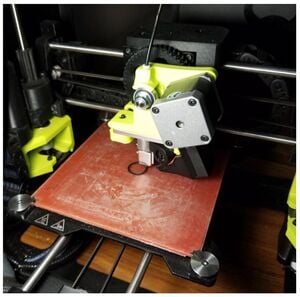
Distributed manufacturing even at the household level is now well established with the combined use of open source designs and self-replicating rapid prototyper (RepRap) 3-D printers. Previous work has shown substantial economic consumer benefits for producing their own polymer products. Now flexible filaments are available at roughly 3-times the cost of more conventional 3-D printing materials. To provide some insight into the potential for flexible filament to be both technically feasible and economically viable for distributed digital manufacturing at the consumer level this study investigates 20 common flexible household products. The 3-D printed products were quantified by print time, electrical energy use and filament consumption by mass to determine the cost to fabricate with a commercial RepRap 3-D printer. Printed parts were inspected and when necessary tested for their targeted application to ensure technical feasibility. Then, the experimentally measured cost to DIY manufacturers was compared to low and high market prices for comparable commercially available products. In addition, the mark-up and potential for long-term price declines was estimated for flexible filaments by converting thermoplastic elastomer (TPE) pellets into filament and reground TPE from a local recycling center into filament using an open source recyclebot. This study found that commercial flexible filament is economically as well as technically feasible for providing a means of distributed home-scale manufacturing of flexible products. The results found a 75% savings when compared to the least expensive commercially equivalent products and 92% when compared to high market priced products. Roughly, 160 flexible objects must be substituted to recover the capital costs to print flexible materials. However, as previous work has shown the Lulzbot Mini 3-D printer used in this study would provide more than a 100% ROI printing one object a week from hard thermoplastics, the upgrade needed to provide flexible filament capabilities can be accomplished with 37 average substitution flexible prints. This, again easily provides a triple digit return on investment printing one product a week. Although these savings, which are created by printing objects at home are substantial, the results also have shown the savings could be further increased to 93% when the use of a pellet extruder and TPE pellets, and 99% if recycled TPE filament made with a recyclebot is used. The capital costs of a recyclebot can be recovered in the manufacturing of about 9 kg of TPE filament, which can be accomplished in less than a week, enabling improved environmental impact as well as a strong financial return for heavy 3-D printer users.
- Supplementary: http://www.mdpi.com/2227-7080/5/4/71/s1
- Lulzbot Mini - source code: http://download.lulzbot.com/Mini/
- Flexystruder - source code: http://download.lulzbot.com/Mini/accessories/Flexystruder_v2/
- Recyclebot
Keywords[edit | edit source]
distributed manufacturing; additive manufacturing; 3-D printing; consumer; economics; open-source; flexible materials; thermoplastic elastomer; thermoplastic polyurethane
See also[edit | edit source]
| Economic Advantage to Making Your Own Stuff with 3D Printing |
|---|
- Economic Impact of DIY Home Manufacturing of Consumer Products with Low-cost 3D Printing from Free and Open Source Designs
- Emergence of Home Manufacturing in the Developed World: Return on Investment for Open-Source 3-D Printers
- Life-cycle economic analysis of distributed manufacturing with open-source 3-D printers
- Impact of DIY Home Manufacturing with 3D Printing on the Toy and Game Market
- Quantifying the Value of Open Source Hardware Development
- Open-source, self-replicating 3-D printer factory for small-business manufacturing
- Distributed manufacturing with 3-D printing: a case study of recreational vehicle solar photovoltaic mounting systems
- Global value chains from a 3D printing perspective
- Economic Potential for Distributed Manufacturing of Adaptive Aids for Arthritis Patients in the U.S.
- Low-cost open source ultrasound-sensing based navigational support for visually impaired
- Open-Source Medical Hardware for Pandemics
- Open source surgical fracture table for digitally distributed manufacturing
- ---
- Matter Hackers guide to success with flexible filament
In the News[edit | edit source]
- Michigan Tech study asks how flexible 3D printing can save costs at home 3D Printing Industry
- Is Flexible 3D Printer Filament Worth the Investment? 3DPrint
- Is distributed manufacturing with flexible 3D printing filament worth it? Michigan Tech finds out 3Ders
- Is 3D printing with flexible filament give value? The researcher finds out! 3D Hoo (Chinese)
- 密歇根理工学院研究3D打印与零售店购买产品相比是否可以灵活地节省家庭成本 News 3D (China)
- 3D打印与零售店购买产品相比是否可以灵活地节省家庭成本 3D Day
- What if you could 3D print everything you need? A study of Michigan Tech 3D Adept
- THE ECONOMIC BENEFITS OF USING NINJAFLEX TPU FILAMENT - Ninjatek
- Make Your 3D Printer Pay for Itself Machine Design, New Equipment Digest






